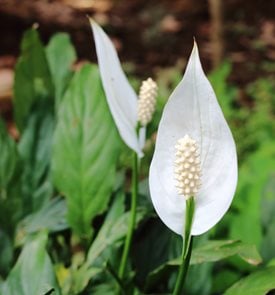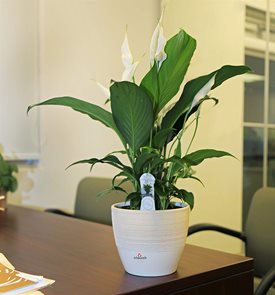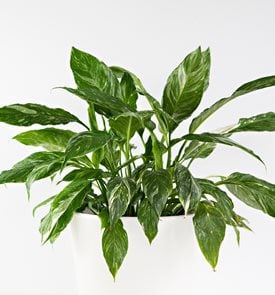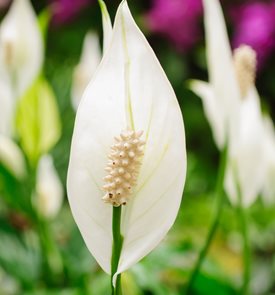A GUIDE TO GROWING PEACE LILY
Add this easy-care houseplant to your home for instant flower power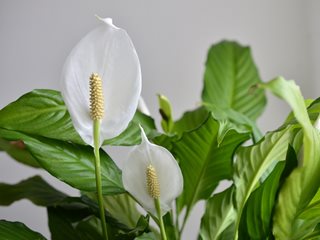
Photo by armifello / Shutterstock
Peace lily is one of the most popular houseplants for good reason: in addition to its exotic blooms and luxurious foliage, it's also one of the easiest flowering indoor plants to grow. This tropical plant—which is not a true lily—is also known as spath lily, Madonna lily, or white sails.
Peace lily is related to other popular houseplants such as philodendron, dumbcane, and elephant ears. It grows best in conditions that mimic its native tropical habitat, but is highly adaptable to the average indoor environment. Plants vary in size from diminutive dwarfs to larger specimens up to 6 feet tall, making peace lily a versatile choice. Best of all, even the most novice indoor gardener will enjoy success with this plant.
On this page: Basics | Growing | Care and Maintenance | Troubleshooting | Peace Lily Varieties | Display Ideas
- PEACE LILY BASICS
- GROWING TIPS
- CARE AND MAINTENANCE
- POSSIBLE PROBLEMS AND SOLUTIONS
- PEACE LILY VARIETIES
- DISPLAY IDEAS
PEACE LILY BASICS
Botanical name:
Spathiphyllum spp.
Hardiness:
Zones 11 to 12. Peace lily can be grown outdoors in warmer regions of Florida and Hawaii.
Light:
Low to medium indirect light; avoid exposing to direct sunlight, which can burn the foliage. Too little light will result in fewer flowers.
Growth rate:
Moderate in optimal growing conditions; growth rate slows in winter.
Habit/Size:
Vase-shaped, compact or upright habit, 6 inches to 6 feet tall and 4 inches to 6 feet wide.
Foliage:
Glossy green foliage is lance-shaped with a rippled texture, occurring in hues of dark green, blue-green, and chartreuse, as well as striped and variegated patterns. Peace lily leaves up to 20 inches long are produced in abundance, emerging from the base of the plant, creating a dense, healthy appearance.
Flowers:
The flower consists of a modified leaf bract that acts as a hood to protect the spadix, which is a spike consisting of tiny flowers. These grow on slender stems above the foliage. The spathe starts out white or cream-colored, fading to green with age, and can last up to a few months. Several occur simultaneously, heaviest in spring, and sporadically throughout the year. Flowers can be lightly fragrant.
Are peace lilies poisonous?
All parts of peace lily can be toxic to pets and children if ingested. Some people may experience skin irritation on contact. See more Poisonous Plants for Dogs and Cats.
GROWING TIPS
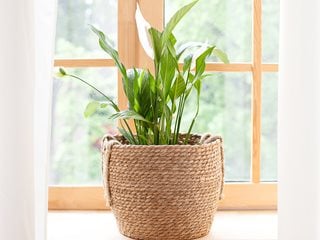
Photo by: stock_studio / Shutterstock
Where to grow:
Site near a window that receives bright but indirect light and avoid cold drafts. Peace lilies, like many other houseplants, can benefit from spending time outdoors in summer. Take plants outside when nighttime temperatures are consistently 60 degrees or higher and place in a shaded spot. Bring indoors if temperatures exceed 90 degrees.
Temperature and humidity:
Ideal temperatures range from 65-80 degrees F. Plants can suffer severe damage or die if exposed to temperatures below 45 degrees F. Peace lily prefers normal or high humidity that mimics its native rainforest habitat, and benefits from supplemental air moisture during winter when home humidity is low.
Soil type:
Grow in a rich, potting mix that contains perlite or bark for drainage. Peace lily prefers a soil pH that is slightly acid or neutral.
Pot requirements:
Plants prefer being slightly rootbound. Grow in a container that is 1 to 2 inches wider than the root ball and has adequate drainage holes.
Propagation:
Peace lily is propagated by root divisions. When plants outgrow their pots, gently cut the root ball in sections that include a portion of the roots and top of the plant. Repot new divisions in containers with fresh soil, leaving an inch or two of space around the root ball. Avoid fertilizing for several months to allow plants to recover from transplant shock.
PEACE LILY CARE AND MAINTENANCE
Care level:
Easy
Watering:
Keep soil evenly moist but not soggy. Don’t allow soil to dry out; plants suffer more from underwatering than overwatering. Keep well-watered in summer, then reduce the amount in winter when plant growth slows down. If tap water is highly chlorinated, use filtered water or allow tap water to sit for a day until chlorine evaporates before using.
Fertilizing:
Feed with a water-soluble houseplant fertilizer at half strength every two months. Cease fertilizing when plant growth slows.
Pruning:
Cut back spent flower stalks to encourage new blooms. Remove damaged foliage as needed.
Repotting:
If plants become excessively rootbound, it’s time to repot into a bigger container. Do this every 1 to 2 years, and transplant in spring when plants are getting ready for a new growth spurt. This is also the time to divide clumps into new plants.
POSSIBLE PROBLEMS AND SOLUTIONS
Wilted, yellow, or brown leaves may be a sign of overwatering or underwatering. Make sure the pot has adequate drainage holes and the planting medium is well-draining. Don’t allow the pot to sit in standing water. Soil that pulls away from the side of the pot or feels dry to the touch is an indication of underwatering. If the pot feels light when it’s lifted up, the soil is dry; if it’s heavy, then soil may be oversaturated.
Scorched or curled, pale leaves can result from too much light, particularly on the side that faces a window. Move plants a few feet away from the window or relocate to another part of the house that receives less light. This can also be caused by summer temperatures over 90 degrees. Move plants to a cooler room during extreme hot spells.
Yellow leaves can be a sign of too much or too little light. Make sure plants are sited near a window that receives indirect medium light and move the plant around until you find a spot where it seems happy.
Brown edges on leaves can be a sign of salt buildup from excess fertilizer. Inadequate drainage can also contribute to salt buildup. Make sure drainage holes allow for water to flush through easily and reduce fertilizing as needed. Plants can also be repotted in fresh soil; withhold fertilizer for several months to allow plants to recover.
Brown leaf tips can occur with underwatering or when room humidity is too low, which is common during winter months when the heat is on. Mist plants weekly, or place pebbles in the saucer underneath the pot and add water to increase air humidity. Don’t allow the bottom of the pot to stay in contact with the water in the saucer.
Root rot can occur if pots are allowed to sit in standing water. Make sure soil drains well and plants are allowed to dry out slightly between watering. Pour out excess water in saucers after watering.
A lack of flowers or gangly plant habit can indicate that the plant is not receiving enough light. Move to a brighter location that doesn’t receive direct sunlight.
Pests: Peace lilies tend to be resistant to pests, but problems can include spider mites, scale, or mealybugs. Wipe affected leaves with a cloth dipped in water or 70% rubbing alcohol, or spray with insecticidal soap or neem oil. (See more on common houseplant pests.)
PEACE LILY VARIETIES
Though there are dozens of peace lily varieties—most of them hybrids—gardeners are most likely to find only a handful of these in garden centers. Novelty varieties include ‘Golden Delicious’, with chartreuse foliage, and ’White Stripe’, which has a single vertical stripe down the center of the leaves.
Also:
‘Power Petite’ (Spathiphyllum hybrid): At 8 to 15 inches tall and 6 to 12 inches wide, this dwarf form has dark green mirror-like leaves and is one of the smallest varieties. Use as a centerpiece for a dining room table or place on an end table or office desk.
‘Mojo’ (Spathiphyllum hybrid): A medium-sized cultivar at 1-1/2 to 2 feet tall and 2 feet wide, this plant has an upright compact habit, dark green leaves, and an abundance of pure white flowers. Place on a large tabletop, plant stand or as a floor accent in a den or bedroom. ‘Mojo Lime’ has chartreuse leaves.
DISPLAY IDEAS
When sold in nurseries and garden centers, peace lilies are often not labelled by variety name. They are sometimes grouped in three size categories: small, medium, and large. Small cultivars reach up to 12 to 18 inches tall and wide; medium-sized plants reach 2 to 3 feet tall; and larger varieties grow 3 to 6 feet tall.
- Display a smaller variety as an attractive centerpiece on a coffee table, end table, book shelf, or desk.
- Place a dwarf variety on a small plant stand, shelf, or hanger in a bathroom so the plant can benefit from the warmth and humidity generated by showers and baths.
- Place a medium-sized variety on a larger dining room table or office boardroom tabletop.
- Keep a small or medium-sized plant near your bedside to reap the benefit of filtering air pollutants while you sleep.
- Use a large specimen as a dramatic focal point in a spacious living room or office lobby.
- Combine peace lily with other exotic-looking houseplants such as elephant ear and parlor palm for a tropical look to stave off the winter blues.
- Plants benefit from being outside during warmer months when temperatures stay between 60-90 degrees F. Place on a shaded patio or porch to add a tropical feel.
RELATED:
The Best Indoor Plants for Any Purpose
Best Low-Light Houseplants
The Best Philodendrons to Grow Indoors
Growing Spider Plants
Snake Plant - A Guide to Growing Sanseveria
